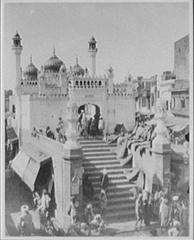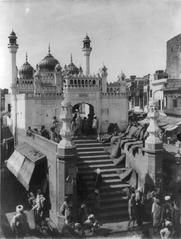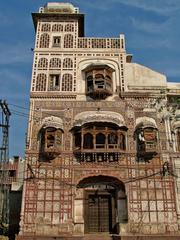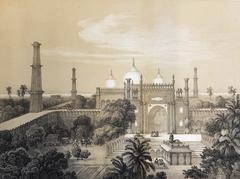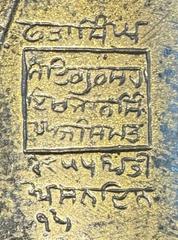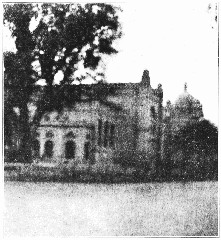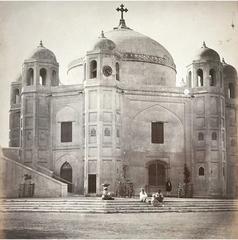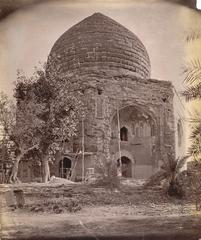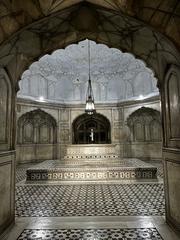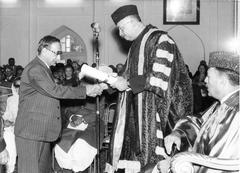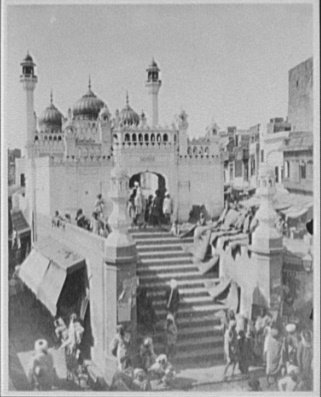
Suneri Mosque Lahore: Visiting Hours, Tickets, and Historical Guide
Date: 14/06/2025
Introduction: The Golden Gem of Lahore
Deep within the vibrant Walled City of Lahore, the Suneri Mosque—also known as Sunehri Masjid or the Golden Mosque—shines as a testament to the city’s layered history, cultural diversity, and enduring architectural brilliance. Built in 1753 during the declining years of the Mughal Empire, this mosque is celebrated for its gilded domes, intricate Mughal-Sikh fusion design, and its unique integration with the local urban fabric through ground-floor shops. Today, it remains both a place of worship and a living cultural landmark, drawing locals and travelers alike to experience its spiritual ambiance and historical significance. (Wikipedia; Youlin Magazine; Oldest.org; Dawn Images)
Table of Contents
- Introduction
- Historical Background
- Architectural Highlights
- Visiting Information
- Nearby Attractions
- Practical Tips for Visitors
- Community and Cultural Events
- FAQs
- Conclusion and Call to Action
- References
Historical Background
Origins and Construction
The Suneri Mosque was commissioned by Nawab Bukhari Khan, deputy governor of Lahore under Muhammad Shah. Built in 1753, as the Mughal Empire’s political influence waned, the mosque was designed to serve the spiritual and communal needs of Lahore’s dense urban center. Uniquely, the mosque’s sustainability was ensured by integrating a row of shops at its base, with rental income funding its maintenance and operations—a solution that overcame initial opposition from local traders and religious figures. (Youlin Magazine; Dawn Images)
Mughal Decline and Sikh Transition
Constructed amid political turbulence, the mosque persisted through the transition from Mughal to Sikh rule in 1765, remaining a center of religious life even as many Islamic monuments fell into neglect. Its enduring relevance was anchored in its commercial ties and its role as a community gathering place. (Dawn Images)
Architectural Highlights
Exterior and Domes
The mosque’s three bulbous domes, originally sheathed in gold leaf, reflect its “Suneri” (golden) epithet. Rising above the bustling Kashmiri Bazaar, the mosque is accessed by a flight of stairs, its elevated position making the golden domes a striking feature of Lahore’s skyline. The façade combines red sandstone and white marble, with a grand arched gateway adorned by floral and geometric patterns. Four slender minarets, capped with golden finials, anchor the mosque’s corners and serve as both architectural and functional elements, historically used for the call to prayer. (Oldest.org)
Courtyard and Interior
Inside, a rectangular courtyard (sahn) with a central ablution fountain welcomes worshippers. The prayer hall dazzles with frescoes, vibrant tile mosaics, and gold leaf accents. Arabic calligraphy and floral motifs decorate the arches and domes, while sunlight filtering through latticework windows creates a dynamic play of light and shadow. The use of “Kashi Kari” (glazed tile work) and local woodwork further showcases the mosque’s blend of artistic traditions. (Oldest.org)
Visiting Information
Hours, Tickets, and Accessibility
- Visiting Hours: Open daily, generally from 7:00 AM to 7:00 PM. During special religious occasions, hours may extend.
- Entry Fee: There is no ticket required or entry fee; donations for maintenance are welcome.
- Accessibility: The mosque’s elevated structure (11 feet above street level, accessible via 16 steps) can pose challenges for those with limited mobility. There are no ramps or lifts. (Beauty of Pakistan)
Dress Code and Visitor Etiquette
- Dress Modestly: Both men and women should cover their arms and legs; women are advised to bring a headscarf.
- Shoes: Remove shoes before entering the prayer hall; racks are provided.
- Photography: Permitted in the courtyard and exterior, but always ask before photographing worshippers.
- Behavior: Silence and respectful conduct are expected, especially during prayers. Non-Muslims should avoid entering the main prayer hall during services. (Iran Charter)
Facilities and Safety
- Ablution Area: Available in the courtyard.
- Shops: Small ground-floor shops sell religious items and snacks, adding to the lively atmosphere.
- Restrooms: Limited; consider using facilities at nearby restaurants.
- Safety: The Walled City is generally safe, but stay alert, especially in crowded bazaars. (Matador Network)
Accessibility for Disabled Visitors
Due to its elevation and lack of ramps, the mosque is not wheelchair-friendly. The surrounding streets are narrow and crowded, posing additional challenges for visitors with mobility impairments.
Guided Tours and Local Guides
No official guided tours are offered, but hiring a local guide is recommended for historical context and easier navigation through the old city. (Against the Compass)
Nearby Attractions
- Lahore Fort
- Badshahi Mosque
- Wazir Khan Mosque
- Shalimar Gardens
- Anarkali and Kashmiri Bazaars
- Tomb of Allama Iqbal
All are within walking or short rickshaw distance, making it easy to combine multiple sites in one trip. (Trek Zone)
Practical Tips for Visitors
- Visit in spring (February to April) for pleasant weather.
- Best lighting for photos is early morning or late afternoon.
- Carry cash in small denominations; credit cards are rarely accepted.
- Wear comfortable shoes for walking on uneven old city streets.
- Bring a translation app if you do not speak Urdu; English is understood in tourist areas, but signage is mostly in Urdu.
- Use the Audiala app for guided tours and updated visitor information.
Community and Cultural Events
During Ramadan and Eid, the mosque is especially lively, hosting communal prayers and gatherings. Visitors may witness or participate in these vibrant community events, gaining deeper insight into Lahore’s living traditions. (Evendo)
Frequently Asked Questions (FAQs)
Q: What are the visiting hours of the Suneri Mosque?
A: Open daily from 7:00 AM to 7:00 PM, with possible extensions during religious festivals.
Q: Is there an entry fee?
A: No, entry is free for everyone.
Q: Are guided tours available?
A: No official tours, but local guides can be hired for a more informative visit.
Q: Is the mosque accessible for people with disabilities?
A: Accessibility is limited due to stairs and narrow streets.
Q: Can non-Muslims visit?
A: Yes, outside of prayer times and with respectful attire.
Q: Is photography allowed?
A: Yes, but always seek permission before photographing people and avoid flash during prayers.
Conclusion and Call to Action
The Suneri Mosque is more than an architectural marvel—it’s a vibrant symbol of Lahore’s enduring heritage, blending Mughal artistry, community spirit, and adaptive urban integration. With free entry, central location, and deep cultural significance, this mosque is a must-visit for anyone exploring Lahore’s historical sites.
Plan your visit during the cooler hours of early morning or late afternoon to witness the mosque’s golden glow and tranquil ambiance. Engage a local guide for enhanced historical perspective, and don’t forget to explore the bustling bazaars and nearby monuments for a comprehensive Lahore experience.
Download the Audiala app for seamless travel planning, updated visitor information, and expertly curated guided tours of Lahore’s treasures. Follow us on social media for more tips, local insights, and exclusive content on Pakistan’s historical wonders.
Visuals and Media

View Sunehri Mosque on Google Maps
References
- Wikipedia
- Youlin Magazine
- Dawn Images
- Oldest.org
- UMT Journal
- Holidify
- Beauty of Pakistan
- Trek Zone
- Evendo
- Matador Network
- Against the Compass
